Speaking at the Whitechapel Gallery last week Mel Bochner, big hitter of the US conceptual art movement, revealed a defining moment for his career in the mid-60s. Soon after graduating, while living in San Francisco, he came across a Picasso painting in Art International that he thought was very badly printed; it was breaking up into dots. The caption was baffling: 'It said the painting was by Roy Lichtenstein, not Picasso. It was a painting of a reproduction of a Picasso painting. I just thought, "How did he even think of doing that".'
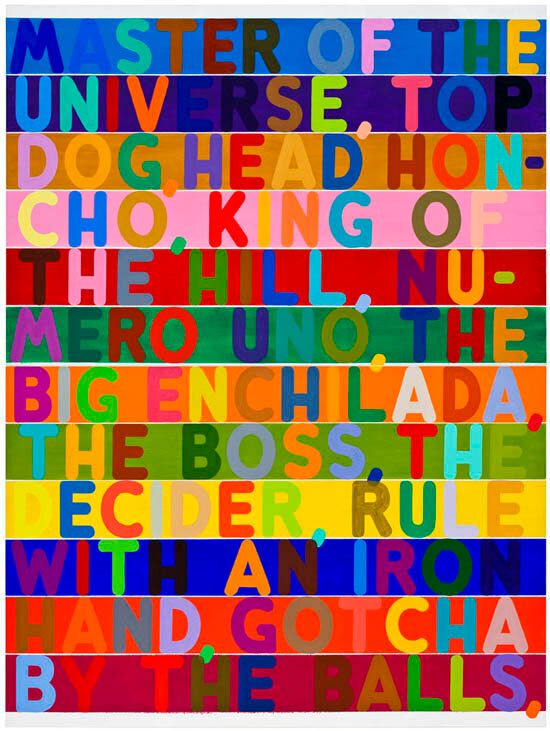
Master of the Universe, 2010, Collection Anita & Burton Reiner, Washington DC, © Mel Bochner
Bochner was speaking in conversation with Achim Borchardt-Hume, chief curator at the gallery, at the start of If The Colour Changes, the first UK survey of Bochner's career. For almost 50 years he has investigated the intersection of thought and sight, language and colour. On entering the gallery, visitors are confronted with his latest work Blah, Blah, Blah (2011), which appears to be a painting but is, in fact, a one-off mechanical print of thick oil paint on black velvet. The rest of the ground-floor gallery presents individual works that have morphed over a 40-year period. Bochner is tenacious and alters the 'delivery system' for his ideas as new technologies become available.
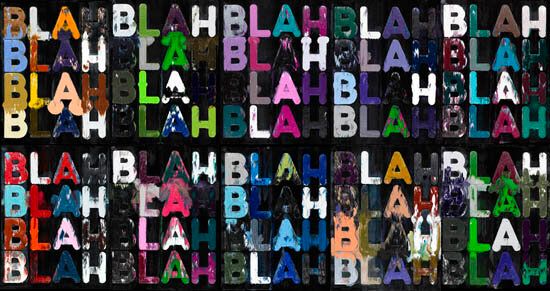
Blah, Blah, Blah, 2011, courtesy Two Palms, New York, © Mel Bochner
Upstairs, in the main gallery, we encounter a fascinating juxtaposition of his 'thesaurus paintings' (2005 onwards) and the multi-canvas artwork Event Horizon (1998). I experienced a mesmerizing pull-push feeling as, first, I locked onto the words in the thesaurus paintings and, second, I refocused to absorb the sometimes subtle and sometimes garish colours. But would another person see the paintings before reading them? When I faced Event Horizon, my immediate instinct was to ask: 'Are the measurements correct? That can't be 34 inches, or can it?' And, I still don't know if the measurements are correct. Bochner seems to be having fun, playing games.
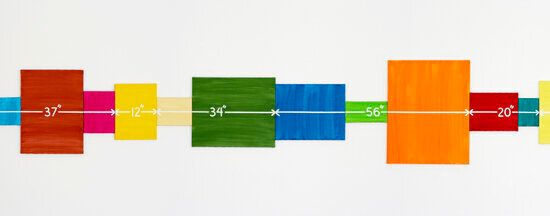
Event Horizon, 1998 (detail), courtesy Peter Freeman Inc., New York, © Mel Bochner
For his thesaurus works, he chooses a word and selects a range of synonyms. He paints these words in a progression from formal words towards slang or a vulgar phrase referring to the body and its functions. Each word is painted a different colour; the colour selection is not pre-planned but made in a manner he considers improvisational. The painting titled Amazing begins with 'AMAZING' painted top left and ends with 'YESSS!' bottom right; Obscene ends with 'HOT N HORNY,' Master of the Universe ends with 'GOTCHA BY THE BALLS,' No ends with 'DROP DEAD.' Bochner has previously stated that if language is our mind, then colour is our body, our emotion.
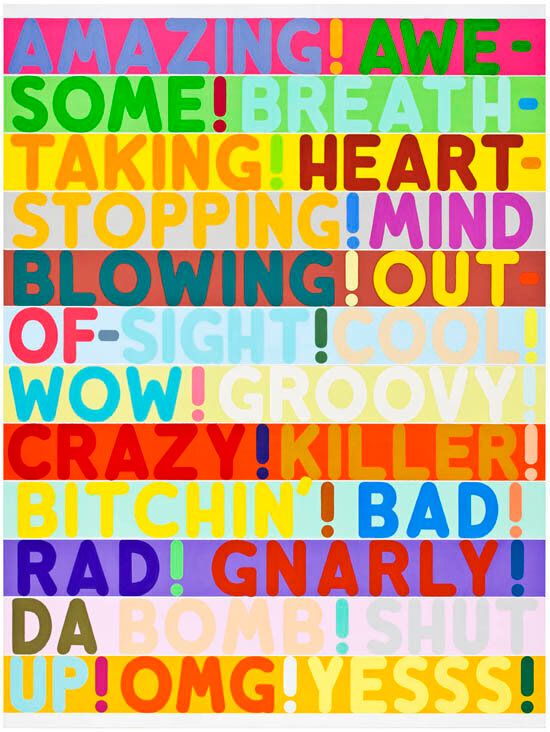
Amazing!, 2011, Midwest Private Collection, © Mel Bochner
The show takes its title from Bochner's 1998 painting, one of his first experiments with language and colour. 'Language kind of snuck up on me,' he said. He explained that he'd been drawing in his notebooks, making notes about his intentions for his number drawings (36 Photographs and 12 Diagrams, 1966-2003). 'I realized I could visualize them without making the work!' This clearly indicates that he sat fair and square within the conceptual art movement. But he resisted the label.
'Conceptual has become a very elastic term but at the time when conceptual art was provocative there were people who took a very anti-visual idea of art. I never subscribed to that idealism. The pendulum has swung back and forth and it has very strongly shifted back to painting on canvas, sculpture, and so on'.
And he stated more than once in the conversation with Borthardt-Hume: 'I'm not afraid of objects.'
'In 1969/70, within a certain constellation of thought, painting per se was a thing of the past.' Painters were looking at anti-composition, so-called all-over painting and they arrived at a 'dead-end,' in a monochrome, he said. 'I thought it would be interesting to think of painting in a theoretical way - and this was before artists were talking about deconstruction. A painting on the floor meant you saw it in perspective and that seemed interesting.' He came across the famous photograph of Matisse standing several feet from a sheet of paper, and drawing on it with the aid of a long stick. Matisse had covered the floor with newspapers. 'That was interesting, too.' And out of this came Theory of Painting (1970).
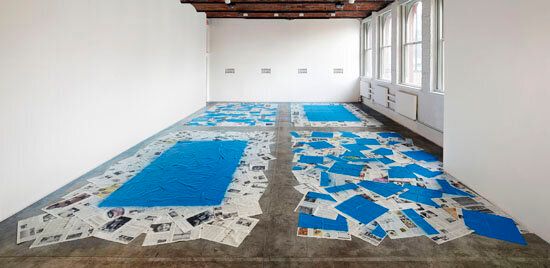
Theory of Painting, 1970, The Museum of Modern Art, New York. Committee on Painting and Sculpture Funds, 1997, © Mel Bochner
For Borchardt-Hume, this survey exhibition provides clear evidence that 'subverting the definition of a medium' has been Bochner's 'consistent philosophical project.' Just as Theory of Painting examined the boundary of painting, Colour Crumple (1967-2011), for example, investigated the boundary of photography.
Indeed, his latest work Blah, Blah, Blah is primarily a subversion of the nature of a print. Although, at first sight, this artwork seems to sit neatly with his thesaurus paintings, I'm not sure it does, and maybe it's not intended to. Bochner has spoken of 'language interrupting the aesthetic enjoyment' of visual art, which is evident in the thesaurus paintings. But in Blah, Blah, Blah the interruption is fleeting: we recognize instantly a single word, repeated. It's easier to focus on, and be seduced by, the lusciousness of the paint. However, the smeared paint on velvet does faintly repel, a reminder of the effect of obscene language in the thesaurus works.
I asked Mel Bochner if the text in Blah, Blah, Blah plays a different role to the text in his thesaurus paintings. He said the text in this latest work represented the 'black hole of language' and the text could be read two ways. It's either dismissive or a short-cut in conversation. I do wonder if Blah, Blah, Blah could mark a transition to a new investigation. But whatever Bochner turns to next it's likely to be as subversive as ever.
Mel Bochner: If The Colour Changes, 12 October - 30 December 2012, Whitechapel Gallery. Organized by the Whitechapel Gallery in collaboration with the Haus der Kunst, Munich, Germany, where it will be shown from 1 March - 16 June 2013 and Museu de Arte Contemporânea de Serralves, Porto, Portugal (12 July - 13 October 2013).